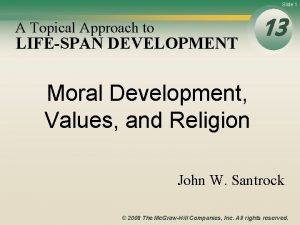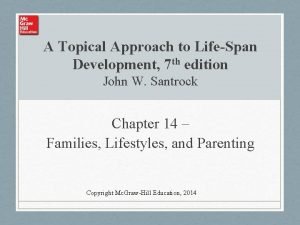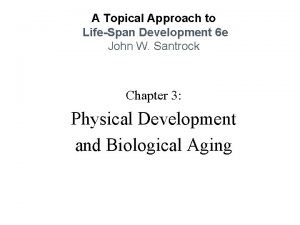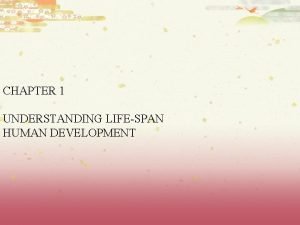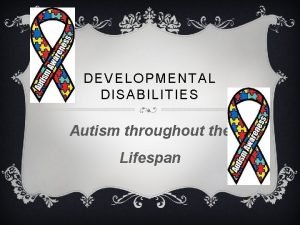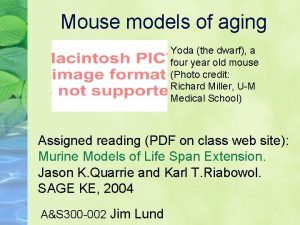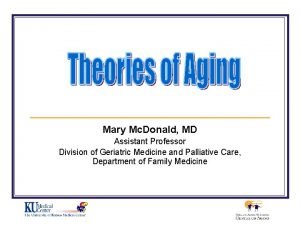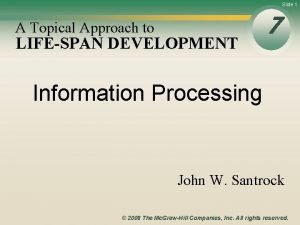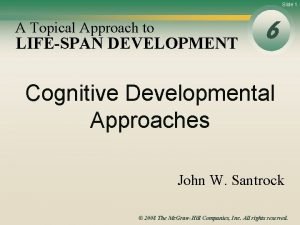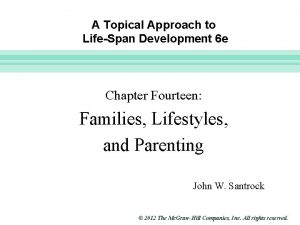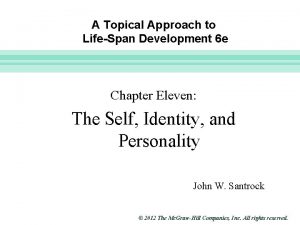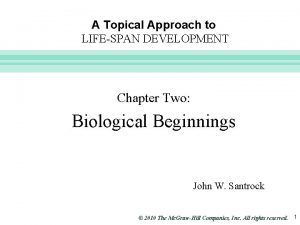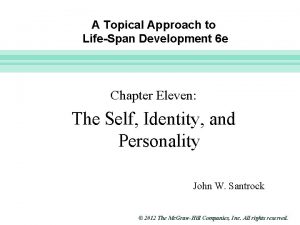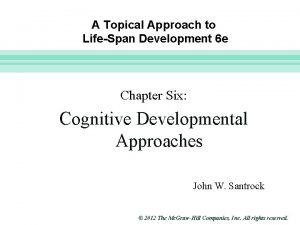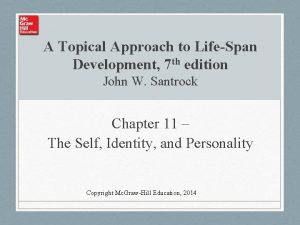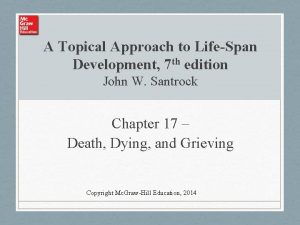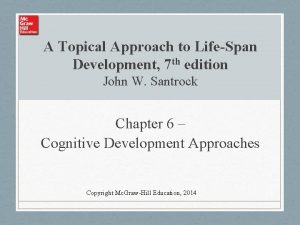Slide 1 A Topical Approach to LIFESPAN DEVELOPMENT


























































- Slides: 58

Slide 1 A Topical Approach to LIFE-SPAN DEVELOPMENT 12 Gender and Sexuality John W. Santrock © 2008 The Mc. Graw-Hill Companies, Inc. All rights reserved.

Slide 2 Gender and Sexuality • Biological, Social, and Cognitive Influences on Gender • Gender Comparisons and Classification • Gender Development through the Life Span • Exploring Sexuality • Sexuality through the Life Span © 2008 The Mc. Graw-Hill Companies, Inc. All rights reserved.

Biological, Social, and Cognitive Influences on Gender Slide 3 Gender and Sex • Gender — characteristics of being female or male – Gender role: set of expectations prescribing how females and males should act, feel, and think – Gender typing: process by which children acquire thoughts, behaviors, and feelings culturally appropriate for their gender • Sex — designates the biological aspects of being female or male © 2008 The Mc. Graw-Hill Companies, Inc. All rights reserved.

Biological, Social, and Cognitive Influences on Gender Slide 4 Gender and Sex • Gender Identity: ages 2 -3 - awareness of own and others’ gender • Gender Stability: ages 3 -4 - aware gender does not change • Gender Constancy: ages 3 -7 - aware will remain a boy or girl even if cuts hair, boys wears ear ring, etc. © 2008 The Mc. Graw-Hill Companies, Inc. All rights reserved.

Biological, Social, and Cognitive Influences on Gender Slide 5 Biological Influences • Chromosomes — 23 rd pair with X and Y • Hormones – Estrogens • Influences development of female physical sex characteristics and helps regulate menstrual cycle – Androgens • Testosterone promotes development of male genitals and secondary sex characteristics © 2008 The Mc. Graw-Hill Companies, Inc. All rights reserved.

Biological, Social, and Cognitive Influences on Gender Slide 6 Biological Influences • Examples of conditions from unusual levels of sex hormones early in development – Congenital adrenal hyperplasia (CAH) – Androgen-insensitive males – Pelvic field defect – Failed sex reassignment © 2008 The Mc. Graw-Hill Companies, Inc. All rights reserved.

Biological, Social, and Cognitive Influences on Gender Slide 7 Evolutionary Psychology View of Gender • Differing roles in reproduction placed different pressures on males and females • Key gender differences in sexual attitudes and sexual behaviors – Males — competition, violence, risk-taking – Females — parenting effort, selection of successful mate © 2008 The Mc. Graw-Hill Companies, Inc. All rights reserved.

Biological, Social, and Cognitive Influences on Gender Slide 8 Social Influences • Differences due to social experiences – Social role theory: gender differences result from contrasting roles of men and women – Psychoanalytic theory of gender: claims child identifies with same-sex parent by age 5 or 6 • Many disagree, claiming gender learned much earlier (even in absence of same-sex parent) © 2008 The Mc. Graw-Hill Companies, Inc. All rights reserved.

Biological, Social, and Cognitive Influences on Gender Slide 9 Social Influences • Differences due to social experiences – Social cognitive theory of gender — gender development results from observation and imitation, use of rewards and punishments for gender-appropriate behaviors • Mothers’ socialization strategies • Fathers’ socialization strategies © 2008 The Mc. Graw-Hill Companies, Inc. All rights reserved.

Biological, Social, and Cognitive Influences on Gender Slide 10 Cognitive Influences • Cognitive development theory of gender – Children’s gender typing occurs after they think of themselves as boys and girls; gender constancy must be achieved first – Once consistently conceived as male or female, children prefer activities, objects, and attitudes consistent with this label © 2008 The Mc. Graw-Hill Companies, Inc. All rights reserved.

Biological, Social, and Cognitive Influences on Gender Slide 11 Cognitive Influences • Gender schema theory – Gender typing emerges gradually in gender schemas of what is culturally gender-appropriate and inappropriate – Gender-typed behavior can occur before children develop gender constancy – Schema: cognitive structure – Gender schema: organizes world in terms of male and female © 2008 The Mc. Graw-Hill Companies, Inc. All rights reserved.

Slide 12 Gender Comparisons and Classification Gender Stereotyping • Broad categories that reflect our impressions and beliefs about females and males – Traditional masculinity and femininity • Males – instrumental traits • Females - expressive traits • Roles and traits – unequal social status, power – Stereotyping varies with culture – Stereotyping of occupations © 2008 The Mc. Graw-Hill Companies, Inc. All rights reserved.

Slide 13 Gender Comparisons and Classification Young Children’s Judgments about Competency in Stereotyped Occupations Fig. 12. 3 © 2008 The Mc. Graw-Hill Companies, Inc. All rights reserved.

Slide 14 Gender Comparisons and Classification Gender Similarities and Differences • Physical differences – Females • have longer life expectancy • less likely to develop mental or physical disorders • Resistant to infections, more elastic blood vessels – Males have higher levels of stress hormones causing faster clotting and higher blood pressure © 2008 The Mc. Graw-Hill Companies, Inc. All rights reserved.

Slide 15 Gender Comparisons and Classification Gender Similarities and Differences • Physical differences – Female brains are smaller, have more folds – Part of hypothalamus involved in sexual behavior is larger in men – Area of parietal lobe functioning in visuospatial skills is larger in males – Areas of brain involved in emotional expression show more activity in females © 2008 The Mc. Graw-Hill Companies, Inc. All rights reserved.

Slide 16 Gender Comparisons and Classification Cognitive Similarities and Differences • Some claim males better at math and visuospatial skills and females better at verbal skills • Others claim differences exaggerated • National standardized tests – Boys slightly better at math and science – Girls better at reading and writing – Overall, girls superior students to boys © 2008 The Mc. Graw-Hill Companies, Inc. All rights reserved.

Slide 17 Gender Comparisons and Classification Visuospatial Skills of Males and Females Fig. 12. 4 © 2008 The Mc. Graw-Hill Companies, Inc. All rights reserved.

Slide 18 Gender Comparisons and Classification Socioemotional Similarities Differences and • Aggression – Males more physically aggressive in all cultures – Females more verbally aggressive; use relational aggression more than men • Self-Regulation – Males show less self-regulation, can lead to behavioral problems • Controversies over psychological differences © 2008 The Mc. Graw-Hill Companies, Inc. All rights reserved.

Slide 19 Gender Comparisons and Classification Socioemotional Similarities Differences and • Overall meta analysis – Gender differences: small to nonexistent – Physical aggression differences were moderate – Largest difference in motor skills favoring males – Males more sexually active than females © 2008 The Mc. Graw-Hill Companies, Inc. All rights reserved.

Slide 20 Gender Comparisons and Classification Socioemotional Similarities Differences and • Gender in context – Gender varies across contexts – Males more likely to help in perceived danger – Females more likely to volunteer to help with child – Girls show more care-giving behaviors than boys – Males more likely to show anger towards strangers and turn anger into aggression – Cultural backgrounds influence socialization © 2008 The Mc. Graw-Hill Companies, Inc. All rights reserved.

Slide 21 Gender Comparisons and Classification Masculinity, Femininity, and Androgyny • Androgyny — presence of masculine and feminine characteristics in same individual – Bem Sex-Role Inventory: • Instrumental, expressive traits • Context influencing gender role is adaptive – Gender-role transcendence — people should be evaluated as persons, not in terms of femininity, masculinity, or androgyny © 2008 The Mc. Graw-Hill Companies, Inc. All rights reserved.

Slide 22 Gender Comparisons and Classification Bem’s Gender-Role Classification Fig. 12. 5 © 2008 The Mc. Graw-Hill Companies, Inc. All rights reserved.

Gender Development through the Life-Span Slide 23 Gender Development in Childhood • Children form many ideas about what the sexes are like from about 1½ to 3 years of age • Boys receive earlier and more intense gender socialization (e. g. : ‘boy code’) • Children show clear preference for same -sex peers © 2008 The Mc. Graw-Hill Companies, Inc. All rights reserved.

Gender Development through the Life-Span Slide 24 Gender Development in Adolescence • Transition point; changes in puberty • Gender-intensification hypothesis – Psychological and behavioral differences between boys and girls become greater during early adolescence – Increased socialization pressures to conform to traditional gender roles – Mixed messages and special problems © 2008 The Mc. Graw-Hill Companies, Inc. All rights reserved.

Gender Development through the Life-Span Slide 25 Communication Between Men and Women • Rapport talk – Language of conversation, a way to establish connections and negotiate relationships – Preferred by women • Report talk – Language designed to give information, including public speaking – Preferred by men © 2008 The Mc. Graw-Hill Companies, Inc. All rights reserved.

Gender Development through the Life-Span Slide 26 Adulthood and Aging • Women’s Gender Development – Women often try to actively participate in others’ development • Emotionally • Intellectually • Socially – Women maintain competency, self-motivation, and self-determination in relationships © 2008 The Mc. Graw-Hill Companies, Inc. All rights reserved.

Gender Development through the Life-Span Slide 27 Adulthood and Aging • Men’s gender development – Male roles are contradictory and inconsistent – Can cause role-strain in • Health • Male-female relationships • Male-male relationships © 2008 The Mc. Graw-Hill Companies, Inc. All rights reserved.

Gender Development through the Life-Span Slide 28 Gender and Aging • Parental imperative – Mothers and fathers adopt different gender roles so they can raise children more effectively – Older women face double jeopardy of ageism and sexism – Older men become more feminine, less active, and more sensitive in relationships © 2008 The Mc. Graw-Hill Companies, Inc. All rights reserved.

Slide 29 Exploring Sexuality Biological and Cultural Factors • Biological – Sexual behavior is influenced by sex hormones – Sexual behavior is so individualized in humans that it is difficult to specify hormonal effects • Sexual motivation also influenced by cultural factors © 2008 The Mc. Graw-Hill Companies, Inc. All rights reserved.

Slide 30 Exploring Sexuality Biological and Cultural Factors • Cultural factors – Range of sexual values across cultures is substantial – Sexual scripts — stereotyped expectancy patterns for how people should behave sexually • Traditional religious script — sex is accepted only within marriage; sex is for reproduction and sometimes affection • Romantic script — sex synonymous with love © 2008 The Mc. Graw-Hill Companies, Inc. All rights reserved.

Slide 31 Exploring Sexuality The 1994 Sex in America Survey Noncohabiting Men Cohabiting (married) Men 1% Never A few times a year Women 3% Women A few times a month 2 to 3 times a week 4 or more times a week Fig. 12. 6 © 2008 The Mc. Graw-Hill Companies, Inc. All rights reserved.

Slide 32 Exploring Sexuality Sexual Orientation • Heterosexual attitudes and behavior – Different categories for frequency of sex – Married couples have sex more often – Most couples enjoy traditional sex – Adultery is exception, not the rule – Men think about sex more than women – Most lead conservative sexual lives © 2008 The Mc. Graw-Hill Companies, Inc. All rights reserved.

Slide 33 Exploring Sexuality Sexual Orientation • Attitudes and behaviors of lesbians and gay males – Bisexual: sexually attracted to both sexes – Research on biological and hormonal differences on sexual preferences unclear – Area of hypothalamus governing sexual behavior 2 x larger in heterosexual males © 2008 The Mc. Graw-Hill Companies, Inc. All rights reserved.

Slide 34 Exploring Sexuality The Continuum of Sexual Orientation 0 1 3 3 4 5 6 Exclusively heterosexual behavior Largely heterosexual but incidental homosexual behavior Largely heterosexual but more than incidental homosexual behavior Equal amounts of heterosexual and homosexual behavior Largely homosexual but more than incidental heterosexual behavior Largely homosexual but incidental heterosexual behavior Exclusively homosexual behavior Fig. 12. 7 © 2008 The Mc. Graw-Hill Companies, Inc. All rights reserved.

Slide 35 Exploring Sexuality Sexual Orientation • Attitudes and behaviors of lesbians and gay males – Gender differences appearing in heterosexual relationships also occurs in homosexual relationships – Gay and lesbians experience life as minorities in dominant culture, with bicultural identity © 2008 The Mc. Graw-Hill Companies, Inc. All rights reserved.

Slide 36 Exploring Sexuality Sexually Transmitted Infections • • • Gonorrhea Syphilis Chlamydia Genital Herpes HPV – causes genital warts AIDS – sexually-transmitted disease caused by the human immunodeficiency virus (HIV) © 2008 The Mc. Graw-Hill Companies, Inc. All rights reserved.

Slide 37 Exploring Sexuality Protecting Against STIs • Education and development of effective drug treatments • Only safe behavior is abstinence • Know your and your partner’s risk status • Obtain screening tests for STIs • Have protected, not unprotected, sex • Don’t have sex with multiple partners © 2008 The Mc. Graw-Hill Companies, Inc. All rights reserved.

Slide 38 Exploring Sexuality Forcible Sexual Behavior • Rape – Forcible sexual intercourse without consent; legal definitions vary by state – Victims reluctant to report rape; stats vary – 5% of rape victims are males – Date or acquaintance rape: coercive sexual activity with acquaintance or better known, a concern for colleges © 2008 The Mc. Graw-Hill Companies, Inc. All rights reserved.

Slide 39 Exploring Sexuality Sexual Harassment • Ranging from remarks to physical contact, blatant propositions to sexual assaults • Most victims are women in educational and workplace settings • Has serious psychological effects on victim • One person’s manifestation of power over another © 2008 The Mc. Graw-Hill Companies, Inc. All rights reserved.

Slide 40 Exploring Sexuality Rape Victim-Offender Relationships 50 Percentage of sample 40 30 20 10 0 Classmate Friend Boyfriend/ ex- Acquaintance boyfriend Other Offender Fig. 12. 8 © 2008 The Mc. Graw-Hill Companies, Inc. All rights reserved.

Slide 41 Sexuality through the Life-Span Child Sexuality • Majority of children engage in some sex play – Usually with friends or siblings – Exhibiting or inspecting the genitals – Most motivated by curiosity – Sex play declines, but sexual interest remains high in elementary school years © 2008 The Mc. Graw-Hill Companies, Inc. All rights reserved.

Slide 42 Sexuality through the Life-Span Adolescent Sexuality • Adolescence – Time of sexual exploration, experimentation, fantasies, and incorporating sexuality into one’s identity – Most have insatiable curiosity about sex – Majority develop mature sexual identity; most have times of vulnerability and confusion – Societies vary in response to adolescent sexuality © 2008 The Mc. Graw-Hill Companies, Inc. All rights reserved.

Slide 43 Sexuality through the Life-Span Developing a Sexual Identity • Multifaceted, lengthy challenge to manage new feelings, develop identity and selfregulation • Great variety in orientations, interest levels, anxiety levels, activity, and reasons for choices in activity • Gay or lesbian identity: coming-out • Homosexual behavior in adolescence may not continue into adulthood © 2008 The Mc. Graw-Hill Companies, Inc. All rights reserved.

Slide 44 Sexual Behavior—Sexual Orientation • Myths of Homosexuality: – Seduction theory: gays and lesbians seduced in childhood by adults of same sex. – “By default” theory: gays and lesbians unable to attract partners of opposite sex. – Poor parenting: gay men = domineering mothers, weak fathers’ lesbian women = weak or absent mothers. – Modeling theory: children imitate gay or lesbian parents. 44 © 2008 The Mc. Graw-Hill Companies, Inc. All rights reserved.

Slide 45 Sexual Behavior—Sexual Orientation • Current Research on Homosexuality: – Genetics: twin studies suggest genetic influence on sexual orientation. – Prenatal hormones: affect fetal brain development and sexual orientation. – Note: Ultimate causes of sexual orientation unknown, but genetics and biology are believed to play dominant roles. 45 © 2008 The Mc. Graw-Hill Companies, Inc. All rights reserved.

Slide 46 Sexuality through the Life-Span Adolescent Sexual Behaviors • U. S. survey of sexual behavior – – Most have sex after age 15, 80% by age 19 First voluntary partner for girls is about same age Trend: adolescents waiting longer to have sex Casual oral sex is common, increasing; believed to be safer and not really ‘having sex’ © 2008 The Mc. Graw-Hill Companies, Inc. All rights reserved.

Slide 47 Sexuality through the Life-Span Risk Factors, Youth Assets, and Sexual Problems • Personal risk factors – Ineffective or lack of use of contraceptives – Early maturation linked to early sexual initiation; varies by ethnic group and SES – Lack of self-regulation © 2008 The Mc. Graw-Hill Companies, Inc. All rights reserved.

Slide 48 Sexuality through the Life-Span Other Risks • Sexually transmitted infections – 3 million U. S. adolescents acquire STIs annually – Africa: girls infected with HIV by adult men • Adolescent pregnancy – U. S. adolescent pregnancy rates decreasing; but one of highest rates in developed world – Negative consequences for teen mother and child – Cross-cultural studies on sexual active adolescents © 2008 The Mc. Graw-Hill Companies, Inc. All rights reserved.

Slide 49 Sexuality through the Life-Span Consequences of Adolescent Pregnancy • Health risks for mother and child – Low birth rate in newborns linked to infant mortality, neurological problems, childhood illness • Young mothers more likely to – – Drop out of school; were low achievers in school Have history of conduct problems Come from low-income backgrounds Live in poverty © 2008 The Mc. Graw-Hill Companies, Inc. All rights reserved.

Slide 50 Sexual risk taking • Sexually transmitted diseases (STDS) (Table 12 -4 (page 449))- some curable, some not! • Pregnancy Most at risk: • Young first experience, multiple partners, failure to use contraceptives, inadequate sex information (14%) • Socioeconomically disadvantaged communities • Substance use • Antisocial behavior • Association with deviant peers 50 © 2008 The Mc. Graw-Hill Companies, Inc. All rights reserved.

Slide 51 • Peer group most influential • 1/3 give into peer pressure Remember, that intercourse, oral, and anal sex can transmit STDS • Contraceptives: why use/not use- ignorance • Teenage mothers, who are often under more stress than adult mothers, are more likely to abuse their child. 51 © 2008 The Mc. Graw-Hill Companies, Inc. All rights reserved.

Slide 52 Why Adolescents Fail to Use Birth Control 1. due to moral or religious values and beliefs 2. belief that sex should be spontaneous and unplanned, therefore, no time for birth control 3. ignorance about reproductive matters, anatomy, pregnancy 52 © 2008 The Mc. Graw-Hill Companies, Inc. All rights reserved.

Slide 53 4. • • • belief in myths won’t get pregnant the first time cant get pregnant during the period misunderstanding the rhythm method pulling out always works certain positions prevent pregnancy belief that they have to be a certain age to become pregnant use of someone else’s birth control place responsibility on the woman or man, but fails to accept responsibility for self belief that they are ready to be parents; possibly promised to be married 53 © 2008 The Mc. Graw-Hill Companies, Inc. All rights reserved.

Slide 54 5. rape/incest will not result in pregnancy 6. leave it up to God! Condoms are the best protection! Sex information: Tend to get from friends, parents, sex education in school, media. Those who can discuss contraception with parents have more positive attitudes toward safe sex 54 © 2008 The Mc. Graw-Hill Companies, Inc. All rights reserved.

Slide 55 Sexuality through the Life-Span Sexuality and Aging • Emerging adulthood – Time frame for sexual activity and singlehood – Most limit sex partners to 1 or two persons annually – Casual sex more common in ‘hooking up’ – The earlier the age of first sex, the more sexual activity in emerging adulthood – Religious adults have fewer sexual partners © 2008 The Mc. Graw-Hill Companies, Inc. All rights reserved.

Slide 56 Sexuality through the Life-Span Sexuality and Aging • Middle adulthood – Climacteric: midlife transition, fertility ends/declines – Women: Menopause late forties or early fifties; • Perimenopausal is transitional time • Hormone replacement therapy (HRT) – Men — less testosterone, less desire, possible erectile dysfunction (Viagra) • Ability to function slows little, frequency drops © 2008 The Mc. Graw-Hill Companies, Inc. All rights reserved.

Slide 57 Sexuality through the Life-Span Sexuality and Aging • Late adulthood – Men experience more changes than women • Orgasm less frequent • More direct stimulation needed • Erection problems more likely after 65 – Sexuality can be lifelong – Two-thirds of older adults satisfied © 2008 The Mc. Graw-Hill Companies, Inc. All rights reserved.

Slide 58 12 The End © 2008 The Mc. Graw-Hill Companies, Inc. All rights reserved.
 A topical approach to lifespan development
A topical approach to lifespan development Heel and toe polka step
Heel and toe polka step Topical approach in curriculum
Topical approach in curriculum Topical approach definition
Topical approach definition Topical approach definition
Topical approach definition Development through the lifespan 6th edition
Development through the lifespan 6th edition Discontinuous development psychology
Discontinuous development psychology Openstax
Openstax Exploring lifespan development chapter 1
Exploring lifespan development chapter 1 Guidance counselling and lifespan development
Guidance counselling and lifespan development Lifespan development third edition
Lifespan development third edition Lifespan development third edition
Lifespan development third edition Exploring lifespan development chapter 1
Exploring lifespan development chapter 1 Exploring lifespan development chapter 1
Exploring lifespan development chapter 1 What is the life cycle of a snow leopard
What is the life cycle of a snow leopard Pelican eel habitat
Pelican eel habitat Lifespan of fruit to be used in a caramel petit fours
Lifespan of fruit to be used in a caramel petit fours Splendour beetle lifespan
Splendour beetle lifespan Honey bee life cycle
Honey bee life cycle Juan ponce de leon lifespan
Juan ponce de leon lifespan Nn teens
Nn teens Henry hudson lifespan
Henry hudson lifespan Lifespan of every animal
Lifespan of every animal The developing person through the life span 9th edition
The developing person through the life span 9th edition Prairie dog lifespan
Prairie dog lifespan Autism lifespan
Autism lifespan Nutrition across life stages
Nutrition across life stages Life span of eagle
Life span of eagle Da vinci lifespan
Da vinci lifespan Lifespan irb
Lifespan irb Fun facts about henry hudson
Fun facts about henry hudson Portuguese man of war habitat
Portuguese man of war habitat Lifespan of platelets
Lifespan of platelets Nudibranch scientific name
Nudibranch scientific name Zebrafish lifespan
Zebrafish lifespan Name
Name Barriers to problem solving in psychology
Barriers to problem solving in psychology Galapagos turtle lifespan
Galapagos turtle lifespan Yoda lifespan
Yoda lifespan Mary quiceno md
Mary quiceno md Journey across the lifespan
Journey across the lifespan Ecology meaning
Ecology meaning Slide divide slide
Slide divide slide Guidelines for writing a literature review
Guidelines for writing a literature review Types of dosage forms
Types of dosage forms Properties of hydrocarbon bases
Properties of hydrocarbon bases Topical agent meaning
Topical agent meaning Syllabus types
Syllabus types Topical scope in research
Topical scope in research Medication administration test answers
Medication administration test answers Topical dosage forms
Topical dosage forms Situational syllabus
Situational syllabus Translate image
Translate image Teknik pemberian obat topikal
Teknik pemberian obat topikal Oral and topical medication administration posttest ati
Oral and topical medication administration posttest ati Sermon preach
Sermon preach Topical dosage forms
Topical dosage forms Difference between drug and dosage form
Difference between drug and dosage form Local route of drug administration
Local route of drug administration


